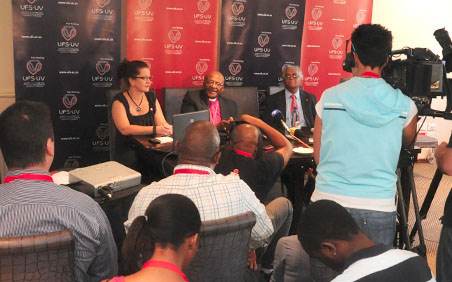 |
The UFS launches it's new International Institute for Studies in Race, Reconciliation and Social Justice.
- Photo: Dries and Henco Myburgh |
Today (Thursday, 27 January 2011), almost three years after the Reitz affair, the University of the Free State (UFS) is launching its International Institute for Studies in Race, Reconciliation and Social Justice. This international institute will be inaugurated by Archbishop Emeritus Desmond Tutu, Nobel Peace Prize Laureate and Chairperson of the former Truth and Reconciliation Commission, who received an honorary doctorate in Theology from the university earlier today.
According to Mr John Samuel, Interim Director of the institute and former Chief Executive Officer of the Nelson Mandela Foundation, the institute seeks to establish itself as a premier international site for research on race, reconciliation and social justice.
“It is encouraging to see the UFS bringing to the fore such an initiative, which combines a study in race, reconciliation and social justice, all of which are indispensible elements in the process of rebuilding our nation,” said the Deputy President of South Africa, Mr Kgalema Motlanthe, in his message of congratulations to the university.
“I am confident that on the strength of its stature, coupled with its eminent experience as an academic institution, the UFS will further assist our country advance towards a united, non-racial, non-sexism, just and prosperous future.
“I wish the institute well in its arduous but noble task of contributing to the building of a better human society,” he said.
Prof. Jonathan Jansen, Vice-Chancellor and Rector, stated during his official inauguration in 2009 that the university would be an example of a place where reconciliation, forgiveness and social justice would not only be studied, but where it would also be applied in practice. “Students and scholars from across the world will come to the UFS to study the theory and practice about the building of societies across the boundaries of race, as well as religion, gender, disabilities and national origin,” Prof. Jansen said.
The institute is a critical space where engaged scholarship, public discussion, community engagement and teaching are innovatively integrated towards exploring and finding solutions to the complex and challenging work of social transformation in South Africa.
The institute furthermore works towards the realisation of its mission through a multiplicity of approaches and methods, informed by the notion that deep and complex social challenges require courageous and challenging scholarship, supported by innovative organisational forms and institutional arrangements.
Working from the inside to the outside, the institute will firstly serve the needs of the university, its staff and students. Through its research, the institute will endeavour to understand the challenges facing the UFS better, as well as how to address these challenges. For this reason, the concept of the UFS as a “live laboratory” and the use of evidence-based practice remain important for the university.
The institute will also reach out and empower its stakeholder communities through research and ongoing involvement on issues of race, reconciliation and social justice. Furthermore the institution expects to contribute to the creation of national and international networks and dialogue platforms pertaining to race, reconciliation and social justice.
For the first five years, the themes of 1) Values, Faith and Social Justice; 2) Development and Social Cohesion; 3) Teaching and Learning for Social Justice; and 4) Provincial, National, Global Perspectives and Leadership will direct the institute’s work.
The UFS will make a substantial contribution to the pursuit of reconciliation, greater social cohesion and equity in South Africa. The university is thus prepared to continue to engage the difficult, practical and trying work of building a strong, quality institution as it promotes racial healing and addresses the structural imbalances of the past. It is at this nexus that the institute commits to enabling change at the university as well contributing to transformation in South Africa.
Media Release
27 January 2011
Issued by: Lacea Loader
Director: Strategic Communication (actg)
Tel: 051 401 2584
Cell: 083 645 2454
E-mail:
news@ufs.ac.za